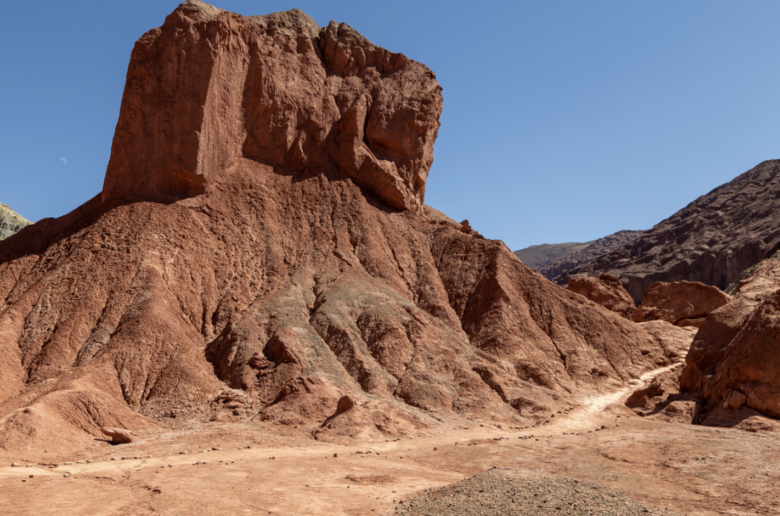Desert of Atacama in Chile.
Most parched non-polar desert in the planet.
Annual rainfall? Less than a millimeter, with some areas having to wait decades for rain.
Temperatures dip below freezing at night, but exceed 30C during the day.
Due of its extreme desolation, NASA utilizes it as a training ground for Mars landings.
In a region where Parkruns are few, how can one plan a nonstop ultramarathon covering 310 miles?
If you’re Nils Arend and you race The Speed Project, the answer is obvious.
Oh, I see.
Line of brief gray presentation. Beach town Iquique, Chile around 4 in the morning in late November.
At a desolate skatepark fifty meters from the Pacific Ocean, ninety runners from across the world are getting ready.
The only creatures out and about are a few stray dogs. Except for the swooping drones of cameras and the anxious jogging of short-shorted runners, there is an unusually quiet atmosphere.
Until a lone voice is heard.
His mild combination of German and American charms everyone around him.
Above all else, it is essential to set out on foot from this location and run across the Atacama Desert following the main route until reaching the ‘finish line’ at San Pedro de Atacama, which is 500km away at an elevation of 2,400m.
This event lacks prize money, rules, a website, and a route, much to Arend’s renowned Los Angeles-to-Las Vegas Speed Project (TSP).
No official admittance is required, same as in LA-LV.
The event is unofficial and unsupported, and invites and intros are sent via Arend’s WhatsApp.
Unproven but certainly seen.
Ex-Olympians, American MTV host Nev Schulman, William Goodge, “real-life Forrest Gump”
The organizers of TSP failed to cheer the runners as they crossed the artificial “start line” that was located on one side of the skate park, the same spot where Arend had been just moments before exiting his pickup truck.
Unsupported racing has been a part of ultra-distance cycling and running for quite some time.
Participation in the beautiful and challenging 4,000 km solo race across Europe known as the Trans Continental Race (TCR) is not allowed for those who accept assistance.
But in TCR and similar events, every rider has a tracking device and there are checkpoints to keep an eye on the field.
Such safeguards for The Speed Project have Arend’s unwavering opposition.
Runners’ comfort zones were tested during TSP Atacama.
If his US and Chilean races were cats, he said in the pre-race briefing that “LA-LV would be a domestic cat, while Atacama would definitely be a tiger.”
Without an authorized route, the TSP Atacama event offers only one resupply option.
So, every squad has a pair of vehicles.
It takes six racers and their support crew a long time to race across moon-like terrain on most US-style flat-bed trucks, what with all the food, petrol, and water they bring.
Every one of the six teams has to have a runner on the one path that goes through this challenging area at all times.
Team captain and leading runner Roberto Mandje is a marathon standout.
Without an authorized route, the TSP Atacama event offers only one resupply option.
So, every squad has a pair of vehicles.
It takes six racers and their support crew a long time to race across moon-like terrain on most US-style flat-bed trucks, what with all the food, petrol, and water they bring.
Every one of the six teams has to have a runner on the one path that goes through this challenging area at all times.
Team captain and leading runner Roberto Mandje is a marathon standout.
Roberto Mandje pauses to catch his breath while driving across the Atacama Desert.
Runner Mandje, a former Olympic medalist, now instructs other runners.
Equatorial Guinean track and field athlete Mandje competed in the 2004 Summer Olympics in Athens.
Mandje made appearances in the World Cross Country and World Trail Racing Championships later in his career.
The 1500-meter dash was his first love in track and field.
A modest, frequent policy helped him and the other fourteen teams.
To complete 500 kilometers in the fastest amount of time, runners would switch places and divide the course into two or three kilometer sections.
To reiterate.
Approximately for twenty-four hours.
I thought, in theory, I could complete each leg. Not quite half a Parkrun.
Mandje claims that the Speed Project took a severe turn in the wee hours of the morning, when he was running on empty after a long day.
Mandje became famous for her high-speed 1500-meter races, in which she would use ice baths and intricate warm-down routines.
Parts of the TSP route had to be walked when he recovered in Chile, where he ate chilly pizza out of a pickup truck.
“What made it really, really challenging is you’re running short intervals and then getting into a van, getting stiff, getting tired, then in another hour you’re jumping back out to run again,” he said.
That becomes old after two days, especially on those sleepy, thinking legs at night.
On the second day, I encountered the most difficult 30-kilometer sector. I had to begin each leg as if I were shuffling walking or fast walking as soon as I got out of the vehicle.
Also, at this point in the journey, you can smell the finish coming, but you still have a long distance to go and a lot of climbing to do.
“But hitting a rough patch was part of the beauty of it.”
This contest was already in jeopardy before Mandje’s problem.
As painful as leg pain was, the strong arm of the law made this far worse.



